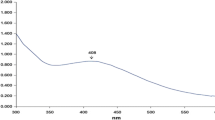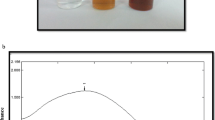Abstract
Purpose
Trichosporon inkin is recognized as one of the vital causative organisms of white piedra in humans. Very few herbal treatments are available against white piedra. Muntingia calabura (MC) leaf extract and silver (Ag) nanoparticles are identified for their numerous therapeutic applications which is the main purpose of this research work.
Methods
In this work, we synthesized, characterized, and studied the stability of Ag nanoparticles embedded in the aqueous extract of MC leaf. The antifungal and antioxidant activity of the Ag nanoparticles embedded MC leaf extract was examined using well diffusion method and 2, 2 diphenyl-1-picrylhydrazyl (DPPH) radical scavenging assay, respectively.
Results
Absorbance peak at 440 nm in UV-visible spectrum confirmed the reduction of silver ions to silver nanoparticles. Dynamic light scattering (DLS) zeta potential analyzer revealed the average particle size of the nanoparticles as 20 nm with the zeta potential of − 18.9 mV. Scanning electron microscope (SEM) analysis showed spherical nanoparticles with a particle size of 20 to 50 nm. Elemental analysis using energy-dispersive x-ray analysis (EDX) identified the presence of Ag. Fourier transforms infrared (FTIR) spectroscopy results predicted functional groups of MC leaf extract and Ag nanoparticles functionalized with MC extract explaining the interaction between them. The crystallinity of silver nanoparticles and particle size was identified using an x-ray diffractometer (XRD).
Conclusions
Ag nanoparticles embedded in MC leaf extract exhibited good stability and possessed good antioxidant activity. The zone of inhibition inferred for the Ag nanoparticles embedded in MC leaf extract determined its antifungal activity against Trichosporon inkin. Hence, the developed Ag nanoparticles embedded in MC leaf extract can be used efficiently in any formulations formulated against Trichosporon inkin.








Similar content being viewed by others
References
Bonifaz A, Gómez-Daza F, Paredes V, Ponce RM. Tinea versicolor, tinea nigra, white piedra, and black piedra. Clin Dermatol. 2010;28(2):140–5.
Mariné M, Brown NA, Riaño-Pachón DM, Goldman GH. On and under the skin: emerging basidiomycetous yeast infections caused by Trichosporon species. PLoS Pathog. 2015;11(7):e1004982.
Kiken DA, Sekaran A, Antaya RJ, Davis A, Imaeda S, Silverberg NB. White piedra in children. J Am Acad Dermatol. 2006;55(6):956–61.
Zhuang K, Ran X, Dai Y, Tang J, Yang Q, Pradhan S, Ran Y. An unusual case of white piedra due to Trichosporon inkin mimicking Trichobacteriosis. Mycopathologia. 2016;181(11–12):909–14.
Tendolkar U, Shinde A, Baveja S, Dhurat R, Phiske M. Trichosporon inkin and Trichosporon mucoides as unusual causes of white piedra of scalp hair. Indian J Dermatol Venereol Leprol. 2014;80(4):324.
Lin JT, Chang YY, Chen YC, Shen BY, Yang DJ. Molecular mechanisms of the effects of the ethanolic extract of Muntingia calabura Linn. fruit on lipopolysaccharide-induced pro-inflammatory mediators in macrophages. Food Funct. 2017;8(3):1245–53.
Zakaria ZA, Sani MH, Kadir AA, Teh LK, Salleh MZ. Antinociceptive effect of semi-purified petroleum ether partition of Muntingia calabura leaves. Revista Brasileira de Farmacognosia. 2016;26(4):408–19.
Rotta EM, Haminiuk CW, Maldaner L, Visentainer JV. Determination of antioxidant activity and phenolic compounds of Muntingia calabura Linn. peel by HPLC‐DAD and UPLC‐ESI‐MS/MS. Int J Food Sci Technol. 2017;52(4):954–63.
Buhian WP, Rubio RO, Valle DL, Martin-Puzon JJ. Bioactive metabolite profiles and antimicrobial activity of ethanolic extracts from Muntingia calabura L. leaves and stems. Asian Pac J Trop Biomed. 2016; 6(8):682–5.
Premakumari KB, Siddiqua A, Banu S, Josephine J, Jenita L, Raj B. Comparative antimicrobial studies of methanolic extract of Muntingia calabura, Basella alba, and Basella rubra leaves. Research Journal of Pharmacognosy and Phytochemistry. 2010;2(3):246–8.
Ramos S, Oliveira J, da Câmara CA, Castelar I, Carvalho AF, Lima-Filho JV. Antibacterial and cytotoxic properties of some plant crude extracts used in Northeastern folk medicine. Rev Bras Farm. 2009;19(2A):376–81.
Bandeira GN, da Camara CA, de Moraes MM, Barros R, Muhammad S, Akhtar Y. Insecticidal activity of Muntingia calabura extracts against larvae and pupae of diamondback, Plutella xylostella (Lepidoptera, Plutellidae). Journal of King Saud University-Science. 2013;25(1):83–9.
Durán N, Marcato PD, De Souza GI, Alves OL, Esposito E. Antibacterial effect of silver nanoparticles produced by fungal process on textile fabrics and their effluent treatment. J Biomed Nanotechnol. 2007;3(2):203–8.
Nagajyothi PC, Lee KD. Synthesis of plant-mediated silver nanoparticles using Dioscorea batatas rhizome extract and evaluation of their antimicrobial activities. J Nanomater. 2011;1(2011):49.
Pant G, Nayak N, Prasuna RG. Enhancement of antidandruff activity of shampoo by biosynthesized silver nanoparticles from Solanum trilobatum plant leaf. Applied Nanoscience. 2013;3(5):431–9.
Anwar MF, Yadav D, Jain S, Kapoor S, Rastogi S, Arora I, Samim M. size-and shape-dependent clinical and mycological efficacy of silver nanoparticles on dandruff. Int J Nanomed. 2016;11:147.
de Aragão AP, de Oliveira TM, Quelemes PV, Perfeito ML, Araújo MC, Santiago JD, Cardoso VS, Quaresma P, de Almeida JR, da Silva DA. Green synthesis of silver nanoparticles using the seaweed Gracilaria birdiae and their antibacterial activity. Arabian Journal of Chemistry. 2016. https://doi.org/10.1016/j.arabjc.2016.04.014
Kummara S, Patil MB, Uriah T. Synthesis, characterization, biocompatible and anticancer activity of green and chemically synthesized silver nanoparticles—a comparative study. Biomed Pharmacother. 2016;31(84):10–21.
Ahmed S, Ahmad M, Swami BL, Ikram S. Green synthesis of silver nanoparticles using Azadirachta indica aqueous leaf extract. J Radiat Res Appl Sci. 2016;9(1):1–7.
Madhumitha G, Saral AM. Preliminary phytochemical analysis, antibacterial, antifungal and anticandidal activities of successive extracts of Crossandra infundibuliformis. Asian Pac J Trop Med. 2011;4(3):192–5.
Muthu K, Priya S. Green synthesis, characterization and catalytic activity of silver nanoparticles using Cassia auriculata flower extract separated fraction. Spectrochim Acta Part A Mol Biomol Spectrosc. 2017;15(179):66–72.
Mohanty AS, Jena BS. Innate catalytic and free radical scavenging activities of silver nanoparticles synthesized using Dillenia indica bark extract. J Colloid Interface Sci. 2017;15(496):513–21.
Dipankar C, Murugan S. The green synthesis, characterization and evaluation of the biological activities of silver nanoparticles synthesized from Iresine herbstii leaf aqueous extracts. Colloids Surf, B. 2012;1(98):112–9.
Fernández JG, Fernández-Baldo MA, Berni E, Camí G, Durán N, Raba J, Sanz MI. Production of silver nanoparticles using yeasts and evaluation of their antifungal activity against phytopathogenic fungi. Process Biochem. 2016;51(9):1306–13.
Surjowardojo P, Sarwiyono IT, Ridhowi A. Quantitative and qualitative phytochemicals analysis of Muntingia calabura. J Biol Agri Healthcare. 2014;4(16):84–8.
Ren YY, Yang H, Wang T, Wang C. Green synthesis and antimicrobial activity of monodisperse silver nanoparticles synthesized using Ginkgo Biloba leaf extract. Phys Lett A. 2016;380(45):3773–7.
Nazeruddin GM, Prasad NR, Waghmare SR, Garadkar KM, Mulla IS. Extracellular biosynthesis of silver nanoparticle using Azadirachta indica leaf extract and its anti-microbial activity. J Alloy Compd. 2014;15(583):272–7.
Alomri, A.A., Kloub Fares, K.E. and Moustafa, N.E., 2018. Green synthesis of assembled silver nanoparticles in nano capsules of Peganum harmala L leaf extract. Antibacterial activity and conjugate investigation. Cogent Chemistry, (just-accepted).
Rivera-Rangel RD, González-Muñoz MP, Avila-Rodriguez M, Razo-Lazcano TA, Solans C. Green synthesis of silver nanoparticles in oil-in-water microemulsion and nano-emulsion using geranium leaf aqueous extract as a reducing agent. Colloids Surf, A. 2018;536:60–7.
Rasheed T, Bilal M, Iqbal HM, Li C. Green biosynthesis of silver nanoparticles using leaves extract of Artemisia vulgaris and their potential biomedical applications. Colloids Surf, B. 2017;8(58):408–15.
Ratna Raju M, Madhusudhana Rao PV, Seshi Reddy T, Raju MK, Brahmaji Rao JS, Venkatasubramani CR. Elemental analysis of medicinal plants from different sites by instrumental neutron activation analysis. International Journal of Bioassays. 2016;5:4892–6.
Balwe SG, Shinde VV, Rokade AA, Park SS, Jeong YT. Green synthesis and characterization of silver nanoparticles (Ag NPs) from extract of plant Radix Puerariae: An efficient and recyclable catalyst for the construction of pyrimido [1, 2-b] indazole derivatives under solvent-free conditions. Catalysis Communications. 2017.
Mehta BK, Chhajlani M, Shrivastava BD. Green synthesis of silver nanoparticles and their characterization by XRD. Journal of physics: conference series, IOP Publishing. 2017;836(1):012050.
Rajakumar G, Gomathi T, Thiruvengadam M, Rajeswari VD, Kalpana VN, Chung IM. Evaluation of anti-cholinesterase, antibacterial and cytotoxic activities of green synthesized silver nanoparticles using from Millettia pinnata flower extract. Microb Pathog. 2017;28(103):123–8.
Peña-González CE, Pedziwiatr-Werbicka E, Martín-Pérez T, Szewczyk EM, Copa-Patiño JL, Soliveri J, Pérez-Serrano J, Gómez R, Bryszewska M, Sánchez-Nieves J, de la Mata FJ. Antibacterial and antifungal properties of dendronized silver and gold nanoparticles with cationic carbosilane dendrons. International Journal of Pharmaceutics. 2017.
Carmona-Jiménez Y, García-Moreno MV, Igartuburu JM, Barroso CG. Simplification of the DPPH assay for estimating the antioxidant activity of wine and wine by-products. Food Chem. 2014;15(165):198–204.
Zakaria ZA, Balan T, Suppaiah V, Ahmad S, Jamaludin F. Mechanism (s) of action involved in the gastroprotective activity of Muntingia calabura. J Ethnopharmacol. 2014;151(3):1184–93.
Swamy MK, Sudipta KM, Jayanta K, Balasubramanya S. The green synthesis, characterization, and evaluation of the biological activities of silver nanoparticles synthesized from Leptadenia reticulata leaf extract. Appl Nanosci. 2015;5(1):73–81.
Sibi G, Naveen R, Dhananjaya K, Ravikumar KR, Mallesha H. Potential use of Muntingia calabura L. extracts against human and plant pathogens. Pharmacognosy Journal. 2012, 4(34):44–7.
Acknowledgements
The authors acknowledge the basic support from the Anna University Regional Office, Coimbatore.
Author information
Authors and Affiliations
Contributions
All authors contributed to the study conception and design. Material preparation, data collection, and analysis were performed by S. Vignesh Kumar, T. Ramya Sri, and N. Prakash. The manuscript was written by S.Vignesh Kumar and reviewed and edited by E. Muthusankar. All authors have read and approved the final manuscript.
Corresponding author
Ethics declarations
Consent for Publication
We certify this manuscript has not been published elsewhere and is not submitted to another journal. All authors have approved the manuscript and agreed with submission to Journal of Pharmaceutical Innovation.
Conflict of Interest
The authors declare that they have no competing interests.
Additional information
Publisher’s Note
Springer Nature remains neutral with regard to jurisdictional claims in published maps and institutional affiliations.
Rights and permissions
About this article
Cite this article
Kumar, S.V., Sri, T.R., Prakash, N. et al. Preparation and Evaluation of Silver Nanoparticles Embedded in Muntingia calabura Leaf Extract to Cure White Piedra. J Pharm Innov 17, 662–673 (2022). https://doi.org/10.1007/s12247-021-09547-4
Accepted:
Published:
Issue Date:
DOI: https://doi.org/10.1007/s12247-021-09547-4




